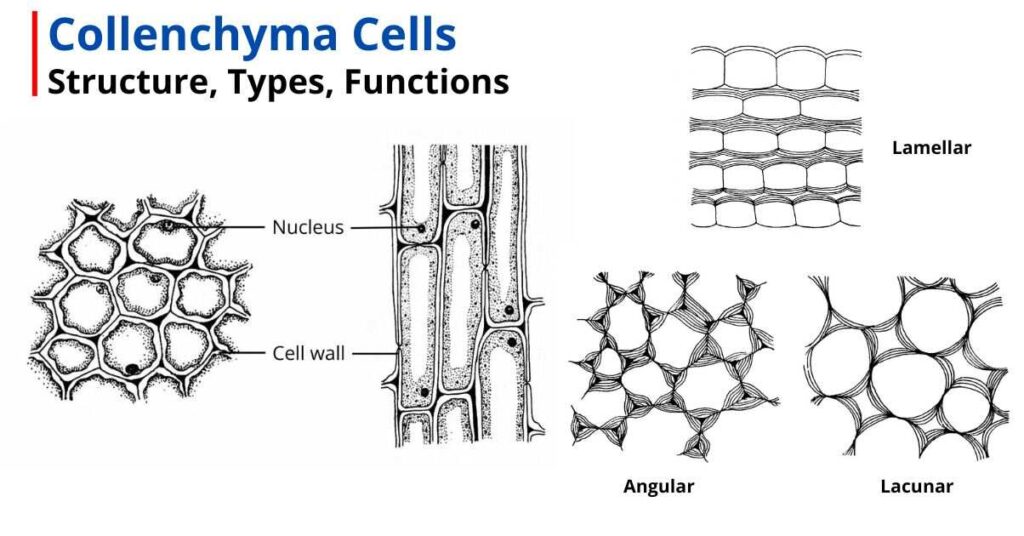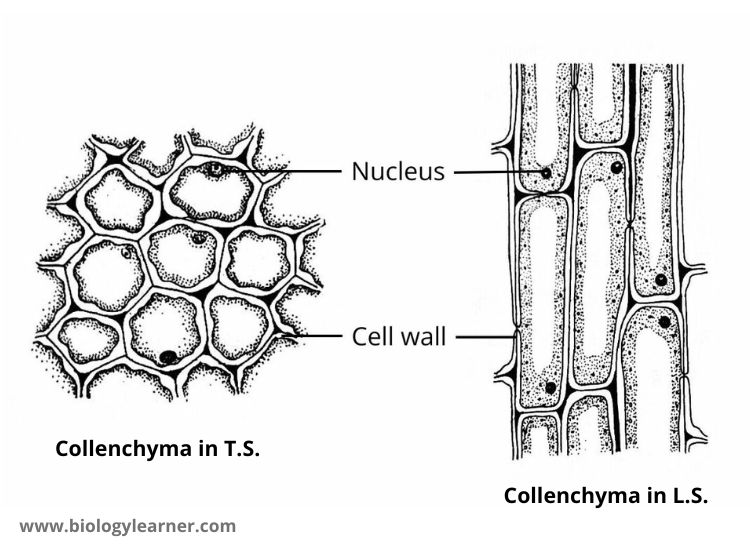Collenchyma is a simple permanent tissue composed of living cells with thickened walls. It is a part of the ground tissue and provides support and mechanical strength to the newly formed plant organs.
The word collenchyma is derived from the Greek words colla and enchyma. Colla means give, and enchyma means infusion (i.e., tissue).

Definition of Collenchyma Cells
Collenchyma cells are irregularly thick-walled, slightly elongated, living cells that give mechanical support to the growing plant organs.
Distribution
- Collenchyma cells are usually found just below the epidermis in the stem of herbaceous dicotyledons.
- They are also found in the petioles (e.g., Begonia) and lamina of leaves (e.g., Nerium).
- They may occur in the root cortex if the root is exposed to light.
- The collenchyma cells are not present in the stem and leaf of monocots.
Structure of Collenchyma Cells
- The collenchyma cells vary considerably in their shape. In a transverse section, they appear as circular, oval, or polygonal.
- They may be short or elongated. The short cells are mostly parenchymatous, while the longer ones resemble the fibres with tapering ends.
- The cell wall is unevenly thick and made up of cellulose, hemicellulose, and pectin.
- These cells can fuse together and form a strong, irregular, functional primary cell wall.
- Intracellular spaces are present in tubular types of cells (e.g., Malva, Salvia).
- Cells have living protoplasm with vacuoles.
- Chloroplasts may be present in the cytoplasm of some collenchyma cells.
- Some cells aslo contain tannins.

Types of Collenchyma Cells
On the basis of cell wall thickenings and the arrangement of cells, collenchyma are of the following types:
1. Angular Collenchyma
- This is the most common type of collenchyma.
- The cells are compact and irregularly arranged without any intercellular spaces.
- The thickenings occur at the corners or angles of the cells.
- Examples: stems of Cucurbita, Tagetes,Dahlia, and Datura and petioles of Begonia, Morus, Coleus, Beta, etc.
2. Lacunar or Tubular Collenchyma
- Here, cells do have intercellular spaces between them.
- The thickenings are primarily deposited around the intercellular spaces.
- Examples: stem of Calotropis and petioles of Althea, Malva, Salvia etc.
3. Lamellar or Plate Collenchyma
- These cells are closely packed without leaving any intercellular spaces.
- The thickenings occur mainly on the tangential walls of the cells.
- Examples: stems of Rhamnus, Helianthus, Raphanus and Sambucus and petiole of Cochlearia.
Functions of Collenchyma Cells
- Collenchyma cells provide mechanical rigidity to the young and growing organs of the plant.
- They also give tensile strength to the plant tissues. As a result, the plant organs become flexible and allowing the plant to bend.
- Chloroplasts containing cells can take part in photosynthesis.
